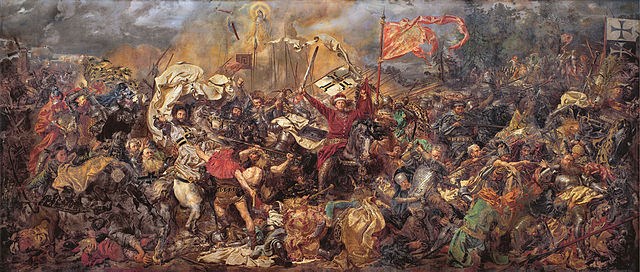
 Bitwa pod Grunwaldem
Bitwa pod Grunwaldem
 Žalgirio mūšis
Žalgirio mūšis
 Schlacht bei Tannenberg
Schlacht bei Tannenberg
 Battle of Grunwald
Battle of Grunwald

 Jan Matejko Bitwa pod Grunwaldem
Jan Matejko Bitwa pod Grunwaldem
 Žalgirio mūšis
Žalgirio mūšis
 Bild von Jan Matejko Schlacht von Grunwald
Bild von Jan Matejko Schlacht von Grunwald
 Battle of Grunwald Artist Jan Matejko
Battle of Grunwald Artist Jan Matejko
Bitwa pod Grunwaldem (w literaturze niemieckiej pierwsza bitwa pod Tannenbergiem) – jedna z największych bitew w historii średniowiecznej Europy (pod względem liczby uczestników), stoczona na polach pod Grunwaldem 15 lipca 1410 w czasie trwania wielkiej wojny między siłami zakonu krzyżackiego wspomaganego przez rycerstwo zachodnioeuropejskie (głównie z Czech, z wielu państewek na Śląsku, z Pomorza Zachodniego i z pozostałych państewek Rzeszy), pod dowództwem wielkiego mistrza Ulricha von Jungingena, a połączonymi siłami polskimi i litewskimi (złożonymi głównie z Polaków, Litwinów i Rusinów) wspieranymi lennikami obu tych krajów (Hospodarstwo Mołdawskie, Księstwo Mazowieckie, Księstwo Płockie, Księstwo Bełskie, Podole i litewskie lenna na Rusi) oraz najemnikami z Czech, Moraw i z państewek ze Śląska oraz uciekinierami ze Złotej Ordy i chorągwiami prywatnymi (między innymi chorągiew z Nowogrodu Wielkiego księcia Lingwena Semena), pod dowództwem króla Polski Władysława II Jagiełły.
Wikipedia - Bitwa pod Grunwaldem
Skrytka:
Pojemnik typu PET. Koordynaty +/- 5m. Weź ołówek.
Powodzenia :-)
Žalgirio mūšis – 1410 m. liepos 15 d. netoli Tanenbergo ir Griunvaldo vykęs mūšis tarp jungtinių Lietuvos Didžiosios Kunigaikštystės ir Lenkijos Karalystės pajėgų ir Teutonų ordino.
Šis mūšis buvo ilgo karinio konflikto tarp Teutonų ordino ir Lietuvos Didžiosios Kunigaikštystės, taip pat latentinės Ordino ir Lenkijos Karalystės priešpriešos, kulminacija. Mūšio metu sutriuškinus Ordino pajėgas prasidėjo Ordino valdžios Prūsijoje silpnėjimas, o Lietuvos ir Lenkijos valstybės tapo Europos didžiosiomis valstybėmis.
Žalgirio mūšis buvo vienas didžiausių Viduramžių riterių kariuomenių mūšių ir nuo XIX a. tapo Lenkijos ir Lietuvos nacionaliniu mitu. Įvairūs šaltiniai vertina, kad pusantros paros trukusiame mūšyje dalyvavo 25 000–85 000 žmonių, o žuvo – 15 000–50 000. Lietuvių-lenkų pusėje dalyvavo samdytos totorių, moldavų, čekų pajėgos, kryžiuočius parėmė riteriai iš įvairių Vakarų Europos šalių.
Mūšis įvyko tuometinėje ordino teritorijoje, į pietvakarius nuo Olštyno, tarp Griunfeldo, Tanenbergo (dab. Stembarkas) ir Liudviksdorfo (dab. Lodvigovas) kaimelių (tuo metu − Prūsijoje, dabar − Lenkijos teritorijoje). Lenkų istoriografijoje šis mūšis minimas kaip Griunvaldo mūšis, lietuvių – Žalgirio mūšis (vok. grün 'žalias' + vok. Wald 'miškas, giria'), Vokietijoje ir Vakarų šalyse – Tanenbergo mūšis (Tanenbergas – vietovė šalia Griunvaldo).
Stendu:
PET taros. Koordinatės + / - 5m. Paimkite pieštuką.
Sėkmės :-)
Die Schlacht bei Tannenberg wurde am 15. Juli des Jahres 1410 im Ordensland Preußen unweit der Orte Tannenberg und Grunwald ausgefochten. Das Heer des Deutschen Ordens unter Hochmeister Ulrich von Jungingen sowie Aufgebote der preußischen Landstände und eine unbekannte Zahl von Söldnern nebst west- und mitteleuropäischen Rittern trug hier das entscheidende Treffen gegen eine gemeinsame Streitmacht des Königreichs Polen unter König Władysław II. Jagiełło sowie des Großherzogtums Litauen unter Großfürst Vytautas aus.
Der seit einem Jahrhundert andauernde kriegerische Konflikt des Ritterordens mit dem Großfürstentum Litauen sowie die latente Rivalität zwischen Deutschem Orden und dem seit 1386 mit Litauen in Personalunion verbundenen Königreich Polen erreichte in dieser Schlacht ihren Höhepunkt. Die schwere Niederlage der Streitmacht des Deutschen Ordens kennzeichnet den Beginn des Niedergangs der Ordensherrschaft in Preußen sowie den Aufstieg Polen-Litauens zur europäischen Großmacht. Die Auseinandersetzung gilt als eine der größten Schlachten zwischen mittelalterlichen Ritterheeren und gehört seit dem 19. Jahrhundert zum Nationalmythos Polens und Litauens.
Wikipedia - Schlacht bei Tannenberg
Cache:
Container nach dem PET. Koordinaten + / - 5m. Nehmen Sie einen Bleistift.
Good luck :-)
The Battle of Grunwald or First Battle of Tannenberg or Battle of Žalgiris (German: Schlacht bei Tannenberg) was fought on 15 July 1410, during the Polish–Lithuanian–Teutonic War. The alliance of the Kingdom of Poland and the Grand Duchy of Lithuania, led respectively by King Władysław Jagiełło and Grand Duke Vytautas (Witold), decisively defeated the German-Prussian Teutonic Knights, led by Grand Master Ulrich von Jungingen. Most of the Teutonic Knights' leadership were killed or taken prisoner. While defeated, the Teutonic Knights withstood the siege on their fortress in Marienburg (Malbork) and suffered only minimal territorial losses at the Peace of Thorn (1411) (Toruń). Territorial disputes continued until the Peace of Melno was concluded in 1422. However, the Knights never recovered their former power and the financial burden of war reparations caused internal conflicts and an economic downturn in their lands. The battle shifted the balance of power in Eastern Europe and marked the rise of the Polish–Lithuanian union as the dominant political and military force in the region.[10]
The battle was one of the largest battles in Medieval Europe and is regarded as the most important victory in the history of Poland, Belarus and Lithuania.[11] It was surrounded by romantic legends and nationalistic propaganda, becoming a larger symbol of struggle against invaders and a source of national pride[citation needed]. During the 20th century, the battle was used in Nazi and Soviet propaganda campaigns. Only in recent decades have historians made progress towards a dispassionate, scholarly assessment of the battle reconciling the previous narratives, which differed widely by nation.
Wikipedia - Battle of Grunwald
Cache:
Container plsatic prepet. Coordinates + / - 5m. Take a pencil.
Good luck :-)
